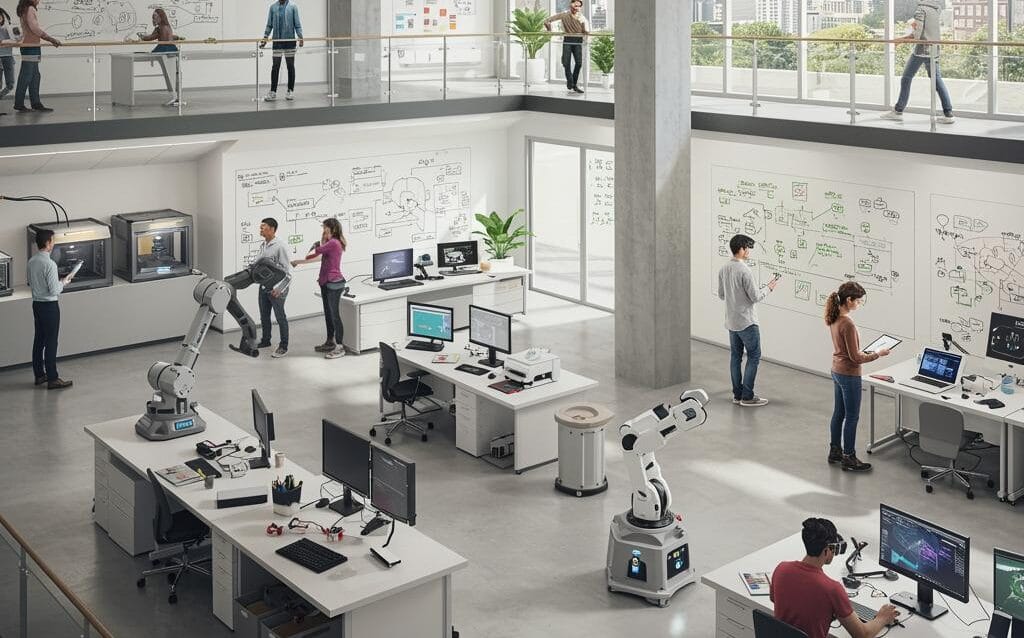Innovation Lab Structure: Space for Tech Experimentation
Innovation Lab Structure: Creating Space for Technological Experimentation
In today’s rapidly evolving technological landscape, fostering innovation is no longer a luxury but a necessity for organizations seeking to stay competitive. An Innovation Lab, designed as a dedicated space for technological experimentation, can be a powerful engine for driving groundbreaking ideas and solutions. However, simply setting aside a room with some gadgets isn’t enough. A well-structured Innovation Lab requires careful planning and execution to maximize its potential. This post will delve into the key components of a successful Innovation Lab structure, providing practical insights and guidance for creating a thriving environment for experimentation.
Key Elements of an Effective Innovation Lab
1. Defining the Lab’s Purpose and Scope
Before embarking on the physical setup, it’s crucial to define the Innovation Lab’s specific purpose and scope. What problems are you trying to solve? What technologies are you focusing on? A clear mission statement will guide resource allocation, project selection, and overall strategy. Consider these questions:
- What are the strategic goals the lab aims to support?
- What are the key areas of technological focus (e.g., AI, blockchain, IoT)?
- What are the success metrics for the lab? (e.g., number of prototypes, patents filed, new product ideas)
- Who is the target audience or user group for the lab’s innovations?
Example: An Innovation Lab in a healthcare organization might focus on developing solutions to improve patient care through telehealth, AI-powered diagnostics, and wearable health monitoring devices.
2. Physical Space and Infrastructure
The physical environment of the Innovation Lab should be conducive to creativity, collaboration, and experimentation. Consider these factors:
- Flexibility: The space should be adaptable to accommodate different types of projects and activities. Modular furniture, movable walls, and flexible layouts are ideal.
- Technology Infrastructure: Ensure access to high-speed internet, powerful computing resources, specialized software, and relevant hardware (e.g., 3D printers, VR headsets, sensors).
- Collaboration Zones: Create dedicated areas for brainstorming, team meetings, and collaborative work sessions. Whiteboards, large displays, and comfortable seating are essential.
- Prototyping Area: A well-equipped prototyping area is crucial for building and testing ideas. This may include tools for electronics, woodworking, metalworking, or software development.
- Presentation Space: A designated area for showcasing prototypes, presenting findings, and sharing knowledge with stakeholders.
Don’t overlook the importance of creating an aesthetically pleasing and inspiring environment. Natural light, comfortable furniture, and visually stimulating elements can significantly boost creativity and productivity.
3. Team Structure and Skill Sets
The success of an Innovation Lab hinges on the talent and expertise of its team. A diverse team with a range of skills and perspectives is essential. Consider including individuals with expertise in:
- Technology: Software development, hardware engineering, data science, AI, and other relevant technical fields.
- Design Thinking: User research, prototyping, user interface (UI) and user experience (UX) design.
- Business Strategy: Market analysis, product management, business development, and financial modeling.
- Project Management: Planning, execution, and tracking of projects.
- Domain Expertise: Deep understanding of the industry or area the lab is focused on.
Important: Foster a culture of continuous learning and development. Encourage team members to attend conferences, take online courses, and explore new technologies.
4. Processes and Methodologies
Establish clear processes and methodologies for managing projects, tracking progress, and evaluating results. Consider adopting agile methodologies, design thinking principles, and lean startup approaches. Key processes include:
- Idea Generation: Implement mechanisms for soliciting ideas from employees, customers, and external sources.
- Project Selection: Establish criteria for evaluating and prioritizing projects based on their potential impact, feasibility, and alignment with strategic goals.
- Prototyping and Testing: Emphasize rapid prototyping and iterative testing to validate assumptions and refine solutions.
- Knowledge Sharing: Create a system for documenting and sharing learnings from both successful and unsuccessful projects.
- Evaluation and Measurement: Track key metrics to assess the impact of the Innovation Lab and identify areas for improvement.
Remember: Embrace experimentation and be prepared for failure. Not all projects will succeed, but even unsuccessful projects can provide valuable insights and lessons learned.
5. Culture of Innovation and Collaboration
Creating a culture of innovation and collaboration is paramount. This involves fostering an environment where:
- Risk-taking is encouraged: Team members feel comfortable experimenting with new ideas and challenging the status quo.
- Collaboration is valued: Cross-functional teams work together seamlessly, sharing knowledge and expertise.
- Open communication is prioritized: Ideas and feedback are shared openly and honestly.
- Learning from failure is embraced: Mistakes are seen as opportunities for growth and improvement.
- Creativity is celebrated: Innovative thinking is recognized and rewarded.
Regularly organize workshops, hackathons, and brainstorming sessions to stimulate creativity and foster collaboration. Encourage team members to attend industry events and connect with other innovators.
Conclusion
Building a successful Innovation Lab is a significant investment, but it can yield substantial returns in terms of new products, services, and processes. By carefully considering the key elements outlined in this post – defining purpose and scope, creating a flexible physical space, assembling a talented team, establishing clear processes, and fostering a culture of innovation – organizations can create a thriving environment for technological experimentation and drive sustainable growth.

